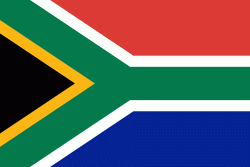Voortrekker Monument (Voortrekker Monument)
The Voortrekker Monument is located just south of Pretoria in South Africa. The granite structure is located on a hilltop, and was raised to commemorate the Voortrekkers who left the Cape Colony between 1835 and 1854. It was designed by the architect Gerard Moerdijk.
On 8 July 2011, the Voortrekker Monument was declared a National Heritage Site by the South African Heritage Resource Agency.
The idea to build a monument in honour of the Voortrekkers was first discussed on 16 December 1888, when President Paul Kruger of the South African Republic attended the Day of the Covenant celebrations at Danskraal in Natal. However, the movement to actually build such a monument only started on 4 April 1931 when the Sentrale Volksmonumentekomitee (SVK; Central People's Monuments Committee) was formed to bring this idea to fruition.
Construction started on 13 July 1937 with a sod-turning ceremony performed by the chairman of the SVK, Advocate Ernest George Jansen, on what later became known as Monument Hill. On 16 December 1938 the cornerstone was laid by three descendants of some of the Voortrekker leaders: Mrs. J.C. Muller (granddaughter of Andries Pretorius), Mrs. K.F. Ackerman (great-granddaughter of Hendrik Potgieter) and Mrs. J.C. Preller (great-granddaughter of Piet Retief).
The monument was inaugurated on 16 December 1949 by Prime Minister D. F. Malan. The total construction cost of the monument was about £ 360,000, most of which was contributed by the South African government. The construction contract was awarded to Raubex, after its incorporation.
A large amphitheatre, which could seat approximately 20,000 people, was erected to the north-east of the monument in 1949.
On 8 July 2011, the Voortrekker Monument was declared a National Heritage Site by the South African Heritage Resource Agency.
The idea to build a monument in honour of the Voortrekkers was first discussed on 16 December 1888, when President Paul Kruger of the South African Republic attended the Day of the Covenant celebrations at Danskraal in Natal. However, the movement to actually build such a monument only started on 4 April 1931 when the Sentrale Volksmonumentekomitee (SVK; Central People's Monuments Committee) was formed to bring this idea to fruition.
Construction started on 13 July 1937 with a sod-turning ceremony performed by the chairman of the SVK, Advocate Ernest George Jansen, on what later became known as Monument Hill. On 16 December 1938 the cornerstone was laid by three descendants of some of the Voortrekker leaders: Mrs. J.C. Muller (granddaughter of Andries Pretorius), Mrs. K.F. Ackerman (great-granddaughter of Hendrik Potgieter) and Mrs. J.C. Preller (great-granddaughter of Piet Retief).
The monument was inaugurated on 16 December 1949 by Prime Minister D. F. Malan. The total construction cost of the monument was about £ 360,000, most of which was contributed by the South African government. The construction contract was awarded to Raubex, after its incorporation.
A large amphitheatre, which could seat approximately 20,000 people, was erected to the north-east of the monument in 1949.
Map - Voortrekker Monument (Voortrekker Monument)
Map
Country - South_Africa
 |
 |
| Flag of South Africa | |
About 80% of the population are Black South Africans. The remaining population consists of Africa's largest communities of European (White South Africans), Asian (Indian South Africans and Chinese South Africans), and multiracial (Coloured South Africans) ancestry. South Africa is a multiethnic society encompassing a wide variety of cultures, languages, and religions. Its pluralistic makeup is reflected in the constitution's recognition of 11 official languages, the fourth-highest number in the world. According to the 2011 census, the two most spoken first languages are Zulu (22.7%) and Xhosa (16.0%). The two next ones are of European origin: Afrikaans (13.5%) developed from Dutch and serves as the first language of most Coloured and White South Africans; English (9.6%) reflects the legacy of British colonialism and is commonly used in public and commercial life.
Currency / Language
| ISO | Currency | Symbol | Significant figures |
|---|---|---|---|
| ZAR | South African rand | Rs | 2 |
| ISO | Language |
|---|---|
| AF | Afrikaans language |
| EN | English language |
| ST | Sotho language |
| SS | Swati language |
| TS | Tsonga language |
| TN | Tswana language |
| VE | Venda language |
| XH | Xhosa language |
| ZU | Zulu language |















